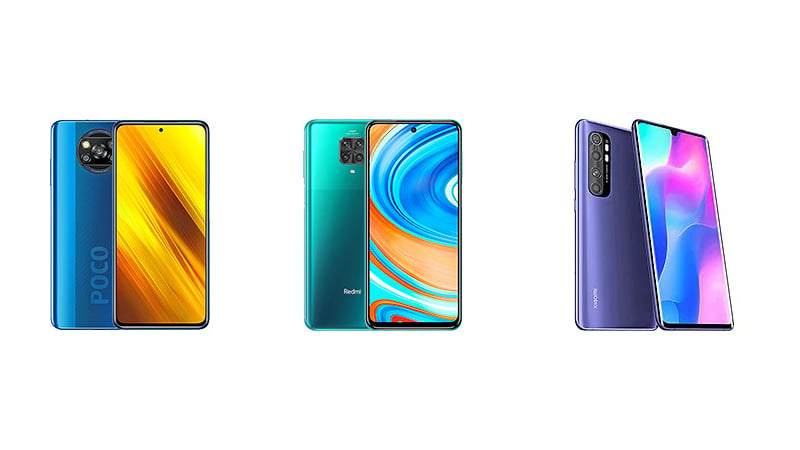Xiaomi just came up with a device that is already considered by a lot of people the smartphone with the highest value for money of 2020: the POCO X3 NFC. With this handset, you get much at a very affordable price. It just launched in the global market, where several Xiaomi budget phones are actually among the best-sellers of the year. Is the new POCO X3 NFC better than every other Xiaomi phone in terms of value for money? Why is it so affordable? It is really the best deal or there are hidden compromises to face? We will try to answer these questions in this comparison between POCO X3 NFC, Xiaomi Mi Note 10 Lite, and Redmi Note 9 Pro.

Xiaomi POCO X3 NFC vs Xiaomi Redmi Note 9 Pro vs Xiaomi Mi Note 10 Lite
| Xiaomi POCO X3 NFC | Xiaomi Mi Note 10 Lite | Xiaomi Redmi Note 9 Pro | |
|---|---|---|---|
| DIMENSIONS AND WEIGHT | 165.3 x 76.8 x 9.4 mm, 215 grams | 157.8 x 74.2 x 9.7 mm, 204 grams | 165.8 x 76.7 x 8.8 mm, 209 grams |
| DISPLAY | 6.67 inches, 1080 x 2400p (Full HD+), IPS LCD | 6.47 inches, 1080 x 2340p (Full HD+), 398 ppi, AMOLED | 6.67 inches, 1080 x 2400p (Full HD+), 395 ppi, IPS LCD |
| PROCESSOR | Qualcomm Snapdragon 732G, octa-core 2.3 GHz | Qualcomm Snapdragon 730G, octa-core 2.2 GHz | Qualcomm Snapdragon 720G, octa-core 2.3 GHz |
| MEMORY | 6 GB RAM, 64 GB – 6 GB RAM, 128 GB – micro SD slot | 6 GB RAM, 64 GB – 8 GB RAM, 128 GB | 6 GB RAM, 64 GB – 6 GB RAM, 128 GB – micro SD dedicated slot |
| SOFTWARE | Android 10, MIUI | Android 10, MIUI | Android 10, MIUI |
| CONNECTIVITY | Wi-Fi 802.11 a/b/g/n/ac, Bluetooth 5.1, GPS | Wi-Fi 802.11 a/b/g/n/ac, Bluetooth 5.0, GPS | Wi-Fi 802.11 a/b/g/n/ac, Bluetooth 5, GPS |
| CAMERA | Quad 64 + 13 + 2 + 2 MP, f/1.8 + f/2.2 + f/2.4 + f/2.4 20 MP f/2.2 front camera |
Quad 64 + 8 MP + 2 + 5 MP f/1.9, f/2.2, f/2.4 and f/2.4 16 MP f/2.5 and f/2.5 front camera |
Quad 64 + 8 + 5 + 2 MP f/1.9, f/2.2, f/2.4 and f/2.2 16 MP f/2.5 front camera |
| BATTERY | 5160 mAh, fast charging 33W | 5260 mAh Fast charging 30W |
5020 mAh, Fast charging 30W |
| ADDITIONAL FEATURES | Dual SIM slot, splash proof | Dual SIM slot | Dual SIM slot |
Design
At a first glance you would not say that Xiaomi Mi Note 10 Lite is the most premium device of this trio because of its waterdrop notch, since its two rivals come with more modern punch-hole display. But the truth is that Xiaomi Mi Note 10 Lite is more compact and it is also made with more premium materials, including a glass back protected by Gorilla Glass 5 and an aluminum frame. With the POCO X3 NFC, you get an aluminum frame but a plastic back, while the Redmi Note 9 Pro has a glass back and a plastic frame. That is why Xiaomi Mi Note 10 Lite wins the design comparison. But you should note that POCO X3 NFC is splash-proof with the IP53 certification.
Display
Do you prefer having an AMOLED display with a standard refresh rate or an IPS panel with a high 120 Hz refresh rate? If you need a better image quality, then you should go for the HDR10 display of the Xiaomi Mi Note 10 Lite coming with the AMOLED technology. If you need a smoother viewing experience because you are a gamer or you just like smoothness, choose the POCO X3 NFC, but you will get an inferior image quality. Redmi Note 9 Pro is pretty disappointing since it sports a classic IPS display with a standard refresh rate. Note that Xiaomi Mi Note 10 Lite has a smaller display than its two opponents (6.47 inches vs 6.67 inches).
Hardware/Software
The most advanced chipset belongs to the POCO X3 NFC: we are talking about the Snapdragon 730G which is actually an upgrade of the Snapdragon 730G found on the Xiaomi Mi Note 10 Lite. But there is something to specify: the differences between Snapdragon 730G and 732G are not big, and the Xiaomi Mi Note 10 Lite offers a higher amount of RAM in its most advanced configuration (8 GB vs 6 GB). That is why Xiaomi Mi Note 10 Lite looks a more interesting choice. We discard the Redmi Note 9 Pro since it comes with a weaker Snapdragon 720G and max 6 GB of RAM. Android 10 is installed out of the box, but only with the POCO X3 NFC you get the MIUI 12 directly.
Camera
With the POCO X3 NFC, you get a slightly better camera experience because it has a better ultrawide sensor with a 13 MP resolution. But its macro camera is inferior with a 2 MP resolution. The differences between the cameras of POCO X3 NFC, Xiaomi Mi Note 10 Lite, and Redmi Note 9 Pro are just marginal and in each case, we are talking about midrange camera phones.
Battery
The Xiaomi Mi Note 10 Lite provides both the biggest battery and the longest battery life because it features a more efficient and smaller AMOLED display. Right after, despite its smaller battery than POCO X3 NFC, there should be Redmi Note 9 Pro because it comes with a standard refresh rate. But the POCO X3 NFC is still a great battery phone.
Price
POCO X3 NFC carries a starting price of just €229/$270 (€199 for the first day) in the global market and it has the best value for the money. But the Xiaomi Mi Note 10 Lite is my favorite one because of its AMOLED display, more premium design, and a bigger battery. However, you have to spend almost €300/$353 to get it. With the POCO X3 NFC around, there is no reason to buy a Redmi Note 9 Pro with the actual prices ranging between €220/$260 and €230/$270, so you should wait for its price to drop if you are interested in it.
Xiaomi POCO X3 NFC vs Xiaomi Redmi Note 9 Pro vs Xiaomi Mi Note 10 Lite: PRO and CONS
Xiaomi POCO X3 NFC
PROS
- Highest value for money
- Better cameras
- 120 Hz display
- Stereo speakers
- Splash proof
- Faster charging tech
CONS
- IPS display
Xiaomi Mi Note 10 Lite
PROS
- Premium design
- AMOLED and HDR display
- Bigger battery
CONS
- Costlier
Xiaomi Redmi Note 9 Pro
PROS
- Very affordable
- Same cameras as the Mi Note 10 Lite
- Thinner
CONS
- Inferior display and hardware







